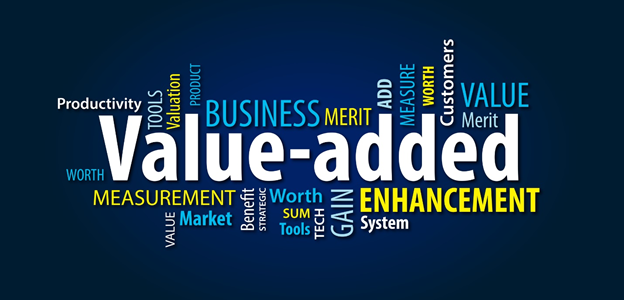What is Value Added?
Value-added means any addition in the form of either improvements or upgrades in any product or service. The additions considered as value-added must all be made before the product or service reaches the end-users. All such additions must enhance the value of the product or service. The concept is beneficial while computing taxes that are charged on value-added. Such taxes are called Value-added taxes.
Value-added: Meaning, Usage & Importance
The concept of value addition can be applied to products, services, firms, management, or even business areas. For example, providing better or extra services in the form of after-sales services and better customer support or a retail seller of computers can add value by including software or computer accessories with the computer's essential product. In addition, strong branding can add value to a product by using a company's logo to sell a product.
Summary
- Value-added means any addition in the form of either improvements or upgrades in any product or service.
- The added value is the actual contribution of a firm in a production process. The returns generated from value addition are distributed to all stakeholders.
- The concept of value addition talks about the efficient use of the resources available using manual skills, technical skills, or any other unique know-how.

Source: © Leese01 | Megapixl.com
Frequently Asked Questions (FAQ)
What are the popular types of value added?
- Gross Value Added (GVA) shows the contribution made to the economy by an individual sector, region, industry, or entity. It measures the gross value added by a particular product, service, or industry. It helps compute the Gross Domestic Product. It indirectly indicates the state of the nation's entire economy. It is computed using the value-added Statement.
- Economic Value Added (EVA) is the difference between the rate of return and its capital cost. It is used to measure the value generated from the funds invested. A lot of financial modelling is required to compute EVA.
- Market Value Added (MVA)- is defined as the difference between the market value and total capital invested. It shows the capacity to increase shareholder value over time. A high MVA indicates effective management, while a low MVA indicates that management's actions and investments value less than investors' contributions.
- Cash Value Added (CVA)- It is helpful to measure the amount of cash a firm generates through its operations. CVA makes investors understand the company's ability to generate cash between periods.
What are the ways to add value?

Source: © Arturszczybylo | Megapixl.com
- Identifying Gaps- It helps in adding in something missing, which is the base of value addition.
- Understanding customer's perspective – producers can make correct value addition by understanding what customers expect from the product or service.
- Getting customer satisfaction – To improve customer satisfaction and add value to goods or services, getting the customer's feedback is essential. Surveys, polls, and customer service professionals add value to service this way.
- Understanding shortfalls and constant evolution – It is crucial to understand the shortfalls and keep evolving to provide customers with the necessary satisfactory product or service. Constant improvement helps in perfect value additions.
- Market Research – To get a return for the value addition, it is essential to do intelligent market research. Understanding the trends and adding value to the products accordingly helps in generating more significant revenue.
Who gains from Value Addition?
There are four primary beneficiaries from value added by a firm: the workers, investors, government, and the owners. It is the people who facilitate value addition.
- Workers-they are a major claimant group of value-added. The payments to the workers are all results of value addition. It may be in the form of wages, bonuses, employer contributions, etc.
- Investors/ Providers of capital- Lenders like banks, financing institutions, the public are all facilitators of funds needed for value addition. They get returns on their funds from value-added services/ manufacturing undertaken.
- Government-The government creates a conducive environment for value addition. The payment it gets in return is in taxes applied on such value additions at each stage.
- Owners- At the end, owners or shareholders get the final claim of the value-added. Returns are in the form of capital gains or profits distributed as dividends.
Example of Value Addition-
A mined resource like Nickel or Silicon is converted after processing into chips or batteries used in modern-day electric vehicles or computers. All the stages involved in making the raw resource into the intelligent chip are all value-added steps. Value is added in each process by different parties, enhancing the use of raw nickel or silicon.
In an industry, a manufacturing business gets raw materials, spares, packaging, etc. It uses these to produce goods sold at prices above the cost. Thus, the business adds value to the materials by making them helpful to end-users. The gap between the sale price and raw material cost is the value-added that has been generated.
Why do we need to measure value added?
- Value-added shows the contribution of a team of employees, managers, shareholders, etc.
- Value-added, if communicated in the form of returns, results in employees working harder.
- Assigning value added to each process helps identify and eliminate unnecessary activities.
- Value added is indicative predictive of a process’s strength.
- It can be used as a basis for wage and salary policies.
- It can be the basis of business policy formulation, like pricing, investment, etc.
- It is another way to measure contribution to national income.
- It helps in understanding the level of tax to be collected by governments.
 Please wait processing your request...
Please wait processing your request...